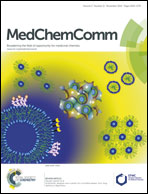Adamantane amine derivatives as dual acting NMDA receptor and voltage-gated calcium channel inhibitors for neuroprotection
Abstract
The pathology of neurodegenerative disorders involves multiple pathways, and it is probably for this reason that targeting one particular step has only yielded limited results. The N-methyl-D-aspartate receptor (NMDAR) allows the influx of calcium ions for normal neuronal functioning. Overactivation of the NMDAR channel leads to excitotoxicity which can ultimately contribute to neuronal cell death. Calcium entry through voltage-gated calcium channels (VGCC) also contributes to this process. This paper describes a series of adamantane-derived compounds, structurally similar to NGP1-01, to act as dual channel inhibitors. By conjugating benzyl and phenylethyl moieties containing different functional groups (–H, –NO2, –NH2, –OCH3) to the structure of amantadine, we were able to synthesise compounds that display both VGCC and NMDAR channel inhibition. Compounds 1, 2, 5 and 10 displayed significant inhibitory activity against both NMDAR channel (66.7–89.5% at 100 μM) and VGCC (39.6–85.7% at 100 μM). The results obtained indicate that these compounds hold potential as neuroprotective drug candidates.


 Please wait while we load your content...
Please wait while we load your content...